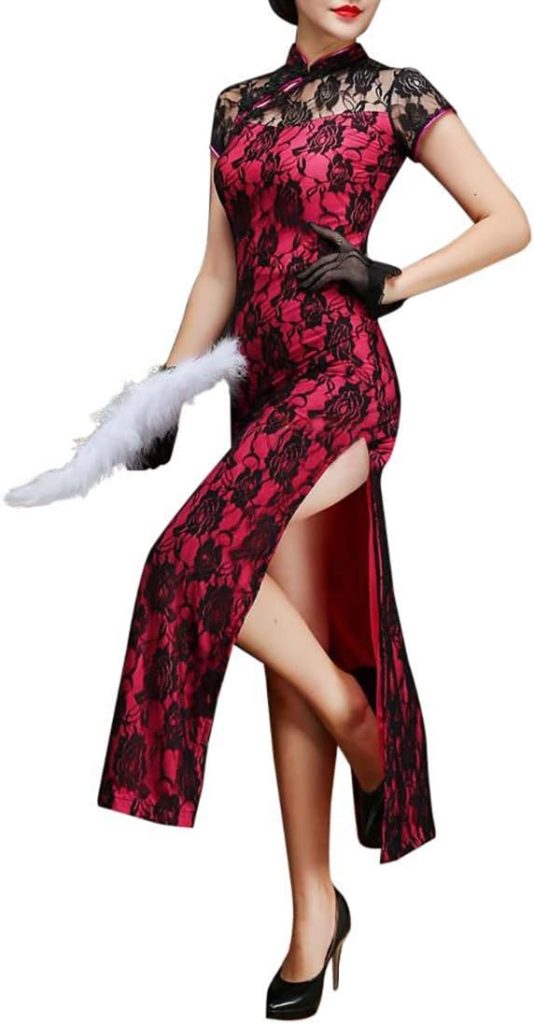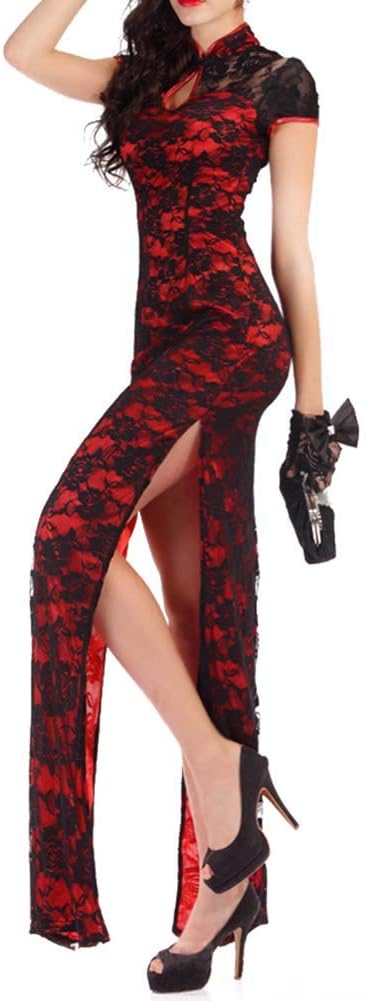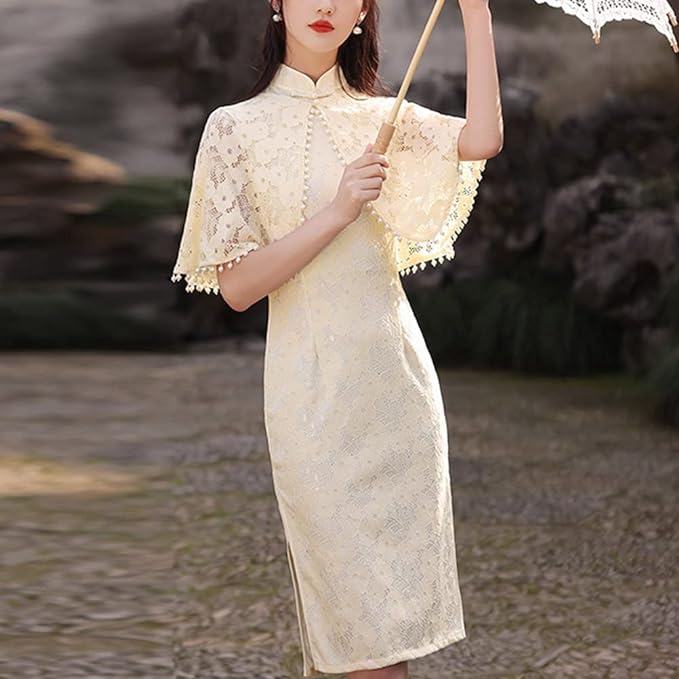The cheongsam and qipao are two terms often used interchangeably to refer to the iconic Chinese dress. However, there are subtle distinctions between these terms that reflect regional and historical influences. In this article, we will delve into the world of cheongsam and qipao dresses, exploring their origins, design features, and cultural significance. By unravelling the distinctions between the cheongsam and qipao, we can gain a deeper understanding of the rich heritage and timeless elegance embodied in these garments.
I. Historical Origins: Tracing the Roots of Cheongsam and Qipao
1.1 Cheongsam: Influences of the Qing Dynasty
The cheongsam dress finds its roots in the Qing Dynasty (1644-1912), characterized by its loose-fitting garments and wide sleeves. The cheongsam evolved from Manchu-style clothing, which incorporated elements such as the loose-fitting silhouette and wide sleeves. As Han Chinese culture blended with Manchu influences, the cheongsam gradually took on a more fitted and elegant form.

1.2 Qipao: A Modern Fusion
The term “qipao” emerged in the early 20th century as a further evolution of the cheongsam. With influences from Western fashion trends, the qipao incorporated elements such as a higher neckline, closer-fitting silhouette, and narrower sleeves. These modifications aimed to create a more modern and streamlined aesthetic, aligning with changing fashion sensibilities of the time.
II. Design Features: Understanding the Characteristics of Cheongsam and Qipao
2.1 Cheongsam: Traditional Elegance
The cheongsam is synonymous with traditional elegance, reflecting the rich heritage of Chinese fashion. Its form-fitting silhouette highlights the natural curves of the wearer, creating a sleek and sophisticated look. The high Mandarin collar further adds to its regal appearance, elongating the neck and giving a nod to the dress’s historical roots.
One distinctive feature of the cheongsam is its straight lines, which create a streamlined and flattering silhouette. The dress is typically tailored to fit closely to the body, accentuating the wearer’s figure and exuding an air of femininity and grace. The narrow waistline further enhances the hourglass shape, adding to its allure.
Traditional cheongsams often showcase exquisite embroidery, a hallmark of Chinese craftsmanship. Intricate motifs inspired by nature, such as delicate flowers, birds, or dragons, are meticulously stitched onto the fabric. These embroidered designs not only add visual appeal but also symbolize prosperity, joy, and good fortune. The artistry of the embroidery on cheongsams reflects the cultural heritage and attention to detail that make these dresses truly exceptional works of art.
2.2 Qipao: Modern Adaptations
The qipao represents a more modern and versatile adaptation of the cheongsam. While it retains the form-fitting silhouette, the qipao incorporates subtle updates to suit contemporary fashion sensibilities. The neckline of the qipao is often more modest, featuring a mandarin collar that exudes elegance and sophistication.
In contrast to the traditional cheongsam, the qipao has narrower sleeves, lending a sleek and refined look. This design choice allows for increased ease of movement and provides a more comfortable fit. These variations in the qipao style reflect the fusion of traditional Chinese aesthetics with Western influences, embracing a global design perspective.

Contemporary adaptations of the dress have further pushed the boundaries, infusing it with modern elements. Designers experiment with diverse fabrics, prints, and embellishments to create unique and eclectic qipao designs. Western-style fabrics such as lace, silk blends, and brocade may be incorporated, resulting in qipaos that showcase a harmonious blend of eastern and western fashion sensibilities.
The versatility of the qipao makes it a versatile dress for various occasions. Its updated design elements allow for greater freedom of movement, making it suitable for both formal events and more casual settings. The qipao’s ability to adapt to modern fashion trends while still showcasing the timeless beauty of Chinese dress is a testament to its enduring appeal.
III. Regional Distinctions: Cheongsam and Qipao across China
3.1 Shanghai Style: The Elegant Qipao
Shanghai is often associated with the epitome of qipao fashion. The Shanghai-style qipao is characterized by its sleek and close-fitting silhouette, delicate embroidery, and elegant fabrics. Qipaos from Shanghai highlight refinement and sophistication, embodying the cosmopolitan flair of the city.
3.2 Cantonese Influence: The Vibrant Cheongsam
In Cantonese regions, the term “cheongsam” is more commonly used. Cantonese-style cheongsams typically feature vibrant colors, rich fabrics, and intricate designs. The embroidery on Cantonese-style cheongsams is especially elaborate, showcasing auspicious symbols and nature-inspired motifs such as peonies or dragons. These cheongsams reflect the colorful and lively culture of southern China.

IV. Cultural Significance: Symbolism and Preservation of Cheongsam and Qipao
4.1 Embodying Cultural Identity
Both the cheongsam and qipao symbolize cultural identity and national pride. These dresses showcase the artistry, elegance, and sophistication of Chinese traditions. Wearing a cheongsam or qipao reflects an appreciation for Chinese cultural heritage and promotes cultural exchange and understanding.
4.2 Preservation and Revival
In recent years, there has been a revival of interest in cheongsam and qipao fashion. Cultural institutions, designers, and enthusiasts have worked tirelessly to preserve and promote these dresses, ensuring that their rich legacy endures. Through fashion shows, exhibitions, and cultural events, the traditions of cheongsam and qipao are kept alive, inspiring new generations to appreciate and embrace the beauty and significance of these garments.

V. Contemporary Expression: Cheongsam and Qipao in Modern Fashion
5.1 Redefining Tradition
Contemporary fashion designers continue to incorporate cheongsam and qipao elements into their collections, redefining these dresses for the modern era. They blend traditional and contemporary motifs, fuse innovative fabrics, and experiment with unique silhouettes, infusing these garments with new life and versatility.
5.2 Global Appeal
Cheongsam and qipao dresses have gained international recognition and appeal. Individuals from various cultural backgrounds appreciate the timeless elegance and cultural heritage these dresses represent. They are worn not only for festive occasions but also for weddings, formal events, and as fashion statements, showcasing a universal admiration for the beauty, craftsmanship, and elegance of Chinese attire.

Celebrating the Distinctions of Cheongsam and Qipao
In conclusion, the cheongsam and qipao dresses, though similar, possess distinct characteristics that reflect historical, regional, and cultural influences. The cheongsam embodies traditional elegance with its form-fitting silhouette and elaborate embroidery, while the qipao represents a fusion of Chinese and global fashion trends. These dresses symbolize the beauty and cultural heritage of China, celebrated by fashion enthusiasts around the world. By understanding the distinctions between the cheongsam and qipao, we gain deeper insights into their cultural significance, and appreciation for the artistry and innovation of Chinese fashion.
